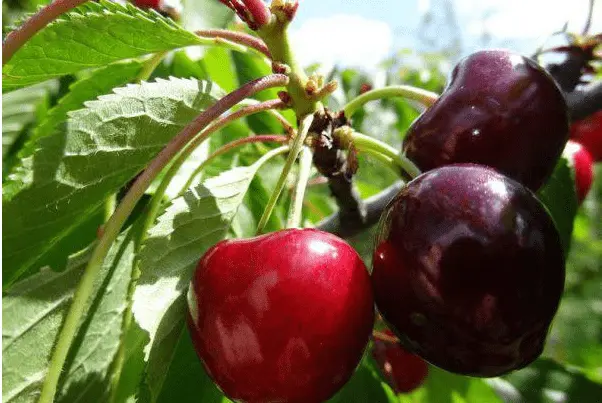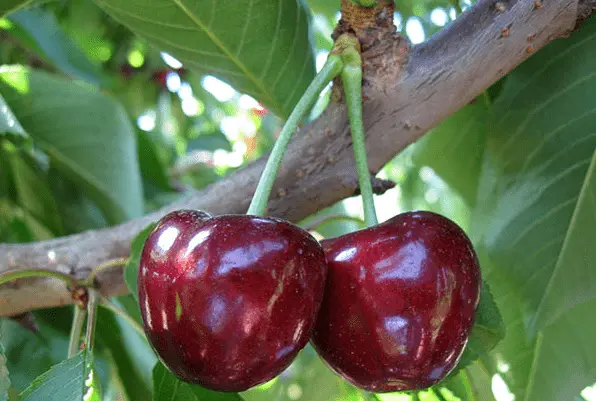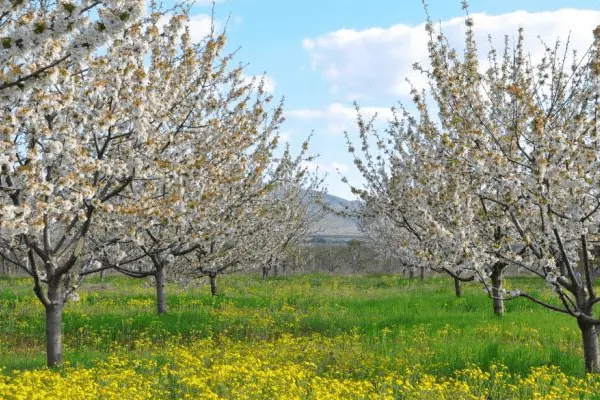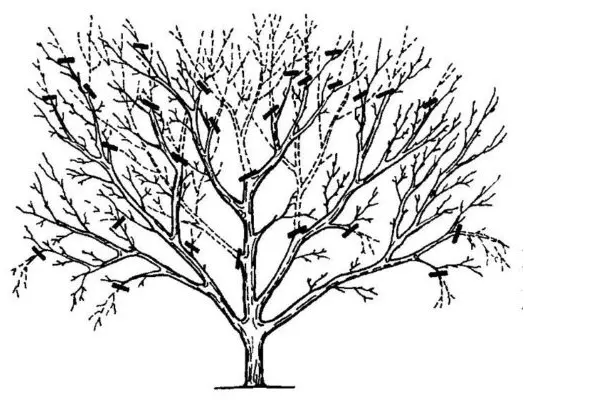Contents
Cherry Bull’s Heart belongs to the large-fruited varieties of this horticultural crop. The original name of the variety is due to the similarity of the fruit in its configuration with the heart of a bull.

History of breeding
Cherry Bull’s Heart has been adapted to regions with a warm climate, since the variety was bred in Georgia.
It is not included in the State Register. Over time, the cultivation area expanded to the middle European zone, thanks to the popularity of juicy, very large fruits.
Description of the culture
After planting, the large-fruited cherry Bull’s Heart shows a rapid growth rate. By the age of five, a rich crown is already formed. After this period, growth processes slow down.
As it matures, the height of the Bull’s Heart cherry tree varies from three to five meters. The crown has a pyramidal shape with an average degree of foliage.
Leaf plates are large, with a dark green color. They have a lanceolate shape with pointed tips and double-serrated edges. The rounded base is attached to a strong short petiole.
Ripe berries reach a weight of up to 12 g. They are covered with dark red dense skin with a pleasant wine tint. The very juicy flesh differs from the peel in a lighter tone. It is sweet, with a pleasant slight sour note that gives the fruit a piquant taste. The bone is removed with little difficulty.

White small flowers are combined into inflorescences. Each of them includes from two to four buds.
After planting on a place prepared in the garden, the Bull’s Heart cherry begins to bear fruit quite early, on average, already in the fourth year.
This variety of sweet cherry, also called Ox’s Heart, was originally recommended for the southern territories. It was cultivated in Azerbaijan, Georgia.
Over time, the cultivation of Bull’s Heart cherries began to be practiced in the conditions of the Black Earth Region and the center of Our Country. Subject to agrotechnical rules and taking into account the characteristics of the variety in relation to the selection of the planting site, it is possible to obtain a stable crop.
Features
Gardeners choose an amazing variety of sweet cherries, which are distinguished by very large berries, taking into account other characteristic features.
Drought resistance, winter resistance
The possibility of cultivating cherries Bull’s heart in an unstable climate is explained by the rather high frost resistance of mature trees. They do not freeze in winter at a temperature of -25˚С.
Oxheart Cherry is able to tolerate short periods of drought, but the trees should not be left without water for more than one month.
Pollination, flowering period and ripening period
Given the self-infertility of the fruit crop, it will be necessary to select suitable pollinators for the Bull’s Heart sweet cherry. Observing an interval of at least 4 meters, the Tyutchevka variety is placed nearby. Suitable as a pollinator cherry Iput or Ovstuzhenka.
In these varieties, the flowering periods that fall on May coincide, which guarantees the necessary pollination of the Bull’s Heart sweet cherry. In such a situation, the trees will please with a bountiful harvest.

Depending on the climatic features of a particular area, the ripening period of the Bull’s Heart sweet cherry varies. In the south, in the gardens, ripe large fruits appear already by the beginning of the summer season. In more northern regions, mass fruiting occurs in the second decade of June.
yield, fruiting
The value of the fruit crop for gardeners lies in the fact that the fruiting of the Bull’s Heart sweet cherry is stable.
The yield is quite high. From each adult tree, up to 60 kg of berries, excellent in taste, are annually obtained.
Scope of berries
Mostly they use juicy, with an excellent taste of cherry berries Bull’s Heart, collected in the period of their full ripening, fresh.
If necessary, they are processed, obtaining compotes with a rich burgundy color, spicy jam, delicious jam.
Disease and pest resistance
An important criterion for choosing a particular species for planting in your own garden is such a characteristic of the Ox Heart cherry variety as the ability to resist the diseases and pests inherent in this culture.
It is noted that the trees of this variety are practically not affected by fungal infection. It is important that coccomycosis, which is dangerous for cherries, is rarely observed on them.
Advantages and disadvantages
Assessing the bull’s heart cherry, you should compare the pros and cons of this culture.
Advantages:
- large fruits;
- outstanding commodity and taste characteristics;
- fairly high winter hardiness;
- rare susceptibility to disease and attack by harmful insects;
- high yield.
Disadvantages:
- fruit deformation during transportation;
- low keeping quality, which does not allow fresh berries to be stored;
- susceptibility of fruits to cracking when overripe, as well as under the influence of temperature fluctuations, direct sunlight, high humidity.
Features of landing
If on a personal farmstead the planting of the Bull’s Heart sweet cherry is carried out taking into account the characteristics of this fruit crop, it is possible to annually obtain tasty healthy fruits of incredible large sizes.
Recommended dates
The preferred period recommended for planting Bull’s Heart cherries in the garden is the spring season. This is due to the ability of a young tree to adapt to new conditions and endure the winter.
Choosing the right place
When choosing a permanent place for Cherry Bull’s Heart, they take into account that this culture will not grow well if aquifers are close to each other.
The site should be well lit by the sun. Protective shields are installed on the north side. Cherry does not like heavy clay and depleted sandy soils.

What crops can and cannot be planted next to cherries
Properly selected neighborhood from other plants provides a decent yield of Bull’s Heart cherries.
It is recommended to plant hawthorn, grapes, mountain ash, cherries. They do not interfere with the development of cherries, so they can grow side by side. Unwanted neighbors are considered apple trees, cherry plums, pears, raspberries, sloes, plums. It is advisable to place them no closer than six meters from the cherry.
Selection and preparation of planting material
When purchasing a seedling of a bull’s heart cherry, you should carefully examine it. It is important that there are no dry or broken branches, bark damage on it.
The seedling should not be deformed or show signs of disease. The most viable will be specimens with a developed root system, dense buds, a neat and noticeable grafting site.
Immediately before planting with a sharp pruner, too long and damaged roots are shortened. The lower part of the seedling is soaked for two hours in settled warm water with a growth stimulator dissolved in it according to the instructions.
Landing algorithm
It is important, after preparing the planting material, to properly plant the Bull’s Heart cherry, maintaining an interval in a row of three meters, and a row spacing of five meters.
Pits for spring planting are dug in the fall. The excavated soil is enriched with mineral complex fertilizer. Sand, rotted compost in equal volumes are added to clay soil.
Planting cherries Bull’s Heart is carried out in the following sequence:
- A wooden stake is driven into the bottom of the planting pit, which will serve as a support for a young tree during gusts of wind.
- A drainage layer is laid, the role of which is played by gravel, broken brick, cobblestones.
- Pour a hill of prepared soil into the center.
- The seedling is installed, carefully straightening and distributing all the roots over the earthen mound.
- Compacting the layers slightly, fill the voids with the soil mixture. The grafting site should rise above the surface.
- Tie a seedling to a support and water it.

Culture aftercare
It should be borne in mind that planting and caring for the Bull’s Heart cherries do not create difficulties for gardeners. The following activities are being carried out:
- Watering an adult tree is required in hot weather four times during the growing season. Young plants need to be watered more often.
- Loosening of the trunk circles is carried out as the crust forms. At the same time, weeds are removed, and then the soil is mulched.
- Cherry top dressing Bull’s Heart involves the spring application of ammonium nitrate. In July, when the crop is already harvested, phosphorus-potassium fertilizers are used. In autumn, it is recommended to scatter rotted compost into tree trunks and loosen the soil.
- In late autumn, pre-winter preparation is carried out. Cherries are watered, trunks and lower large branches are whitewashed with lime.
- Young trees are protected from the cold by wrapping them with spruce branches. In winter, from rodents, the snow around the trunks is trampled down, adding it, if necessary, to the trunk circles.
Annual spring pruning, which forms the crown, is required for the Bull’s Heart sweet cherry from the age of two. Shorten the shoots by a third of the length. In autumn, sanitary cutting of damaged branches is carried out.

Diseases and pests, methods of control and prevention
Under adverse external conditions, irregular thinning of the crown, the bull’s heart sweet cherry can be subject to serious diseases and the development of pests. At the first sign, you need to start the fight to save the trees.
Main diseases:
Name of the disease | Evidence | Control measures | Prevention |
Bacteriosis | Distribution of water spots on all parts of the tree | Watering without excessive waterlogging of the soil | Annual application of nitrogen fertilizers in spring |
Kokkomikoz | Brown marks on leaves | Processing in July, when the crop is fully harvested, with Topaz or Horus preparations | Irrigation at the stage of bud swelling with Bordeaux mixture (0,5%) |
Rot | Gray mold spots on berries | Treatment with preparations “Copper chloride”, “Azophos” | Spraying the crown in April with Bordeaux liquid (0,5%) |
The most common pests:
Name | danger to the plant | Control measures |
cherry fly | The larvae damage the berries | Spraying with insecticides |
cherry shoot moth | Leaf plates, young shoots, buds are destroyed | Irrigation of the crown during the swelling of the kidneys with the preparations “Chlorophos”, “Karbofos” |
Conclusion
Cherry Bull’s Heart, with proper care, allows you to annually receive a bountiful harvest of large fruits with great taste. It should be borne in mind that berries that are easily deformed during transportation are recommended to be grown for their own use, since it is difficult to sell them.
Reviews
To make a complete impression, you should analyze the reviews of gardeners about the bull’s heart cherry.









